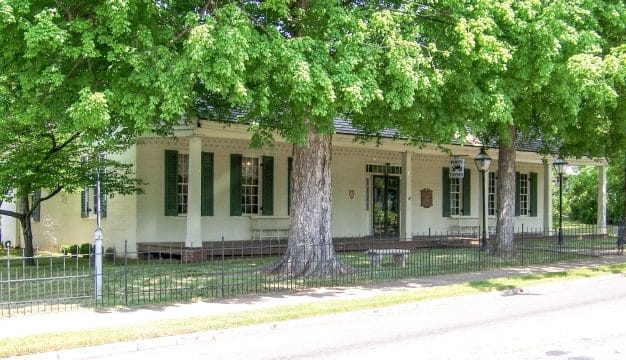Raphael Semmes
 Raphael Semmes
Confederate rear admiral and brigadier general Raphael Semmes (1809-1877) left an enduring legacy as captain of the CSS Alabama, the most famous of the Confederate commerce raiders. Known as the “Nelson of the Confederacy” for his daring exploits, Semmes rallied the hopes of Alabamians and other southerners during the waning days of the Civil War. The climactic duel between the Alabama and the USS Kearsarge in June 1864 contributed to Semmes’s reputation as a hero of the Confederacy despite his defeat in the battle and the loss of his ship. The town of Semmes, Mobile County, is named for him.
Raphael Semmes
Confederate rear admiral and brigadier general Raphael Semmes (1809-1877) left an enduring legacy as captain of the CSS Alabama, the most famous of the Confederate commerce raiders. Known as the “Nelson of the Confederacy” for his daring exploits, Semmes rallied the hopes of Alabamians and other southerners during the waning days of the Civil War. The climactic duel between the Alabama and the USS Kearsarge in June 1864 contributed to Semmes’s reputation as a hero of the Confederacy despite his defeat in the battle and the loss of his ship. The town of Semmes, Mobile County, is named for him.
Raphael Semmes was born in Charles County, Maryland, on September 27, 1809, the fourth child of Richard and Catherine Middleton Semmes. Orphaned at an early age, he was raised by an uncle, Raphael Semmes. Another uncle, Benedict Semmes, helped secure his appointment as a midshipman in the U.S. Navy in 1826. In addition to his training as a naval officer, Semmes also studied law and was admitted to the Maryland bar in 1834. Shore duty allowed him to pursue his law practice, first in Cincinnati, Ohio, where he married Anne Elizabeth Spencer in 1837, the same year he was commissioned a lieutenant. The couple had six children.
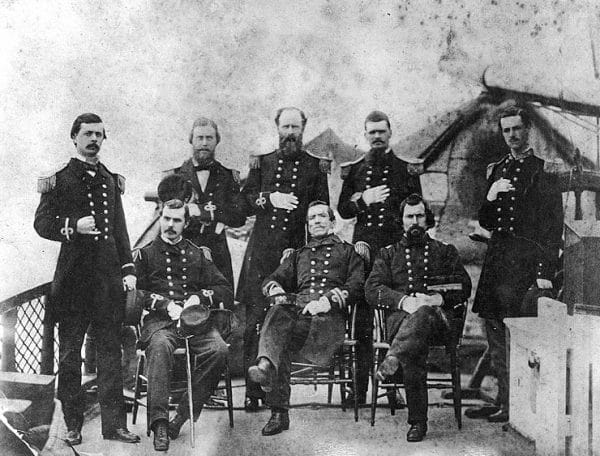 Semmes and Officers of the CSS Sumter
During the Mexican War (1846-48), Semmes commanded the USS Somers, a brig assigned to blockade the Mexican port of Veracruz. A fierce gale caused the ship to founder, and 39 members of the crew lost their lives. Semmes narrowly escaped drowning. A court of inquiry found no fault with Semmes and praised him for the way he handled his ship. Semmes next accompanied Gen. Winfield Scott’s troops as they fought their way to the Mexican capitol, and he ended the war as volunteer aide to Brig. Gen. William J. Worth.
Semmes and Officers of the CSS Sumter
During the Mexican War (1846-48), Semmes commanded the USS Somers, a brig assigned to blockade the Mexican port of Veracruz. A fierce gale caused the ship to founder, and 39 members of the crew lost their lives. Semmes narrowly escaped drowning. A court of inquiry found no fault with Semmes and praised him for the way he handled his ship. Semmes next accompanied Gen. Winfield Scott’s troops as they fought their way to the Mexican capitol, and he ended the war as volunteer aide to Brig. Gen. William J. Worth.
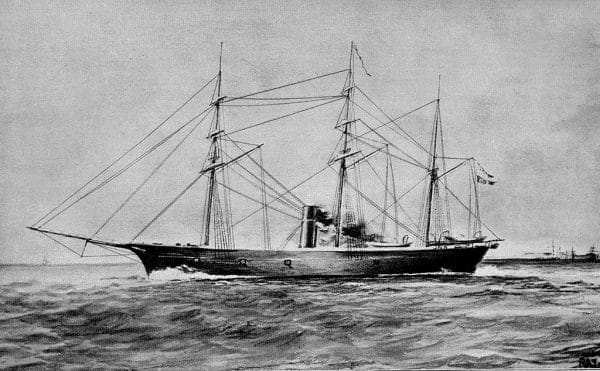 CSS Sumter
After the war, Semmes moved to Mobile, which he would consider his home for the rest of his life. While on shore duty, Semmes practiced law and wrote Service Afloat and Ashore During the Mexican War, a book about his war experiences published in 1851. Semmes was promoted to commander in 1855 and the following year was assigned to the United States Lighthouse Service as an inspector, in Washington, D.C. His strong support for states’ rights and antipathy to the election of a Republican president resulted in his resignation from the U.S. Navy on February 15, 1861, a month after Alabama seceded from the Union. Before hostilities began, Semmes was sent north by Confederate president Jefferson Davis on a secret mission to purchase military supplies for the Confederacy from munitions brokers. Returning to Montgomery, Alabama, on April 4, he learned he had been commissioned a commander in the Confederate Navy. Unhappy at being appointed head of the Confederacy’s Lighthouse Bureau, Semmes convinced Secretary of the Navy Stephen R. Mallory to allow him to convert an unused vessel into a commerce raider. Such ships, he believed, would prove ruinous to the Union’s economy and help secure the South’s independence.
CSS Sumter
After the war, Semmes moved to Mobile, which he would consider his home for the rest of his life. While on shore duty, Semmes practiced law and wrote Service Afloat and Ashore During the Mexican War, a book about his war experiences published in 1851. Semmes was promoted to commander in 1855 and the following year was assigned to the United States Lighthouse Service as an inspector, in Washington, D.C. His strong support for states’ rights and antipathy to the election of a Republican president resulted in his resignation from the U.S. Navy on February 15, 1861, a month after Alabama seceded from the Union. Before hostilities began, Semmes was sent north by Confederate president Jefferson Davis on a secret mission to purchase military supplies for the Confederacy from munitions brokers. Returning to Montgomery, Alabama, on April 4, he learned he had been commissioned a commander in the Confederate Navy. Unhappy at being appointed head of the Confederacy’s Lighthouse Bureau, Semmes convinced Secretary of the Navy Stephen R. Mallory to allow him to convert an unused vessel into a commerce raider. Such ships, he believed, would prove ruinous to the Union’s economy and help secure the South’s independence.
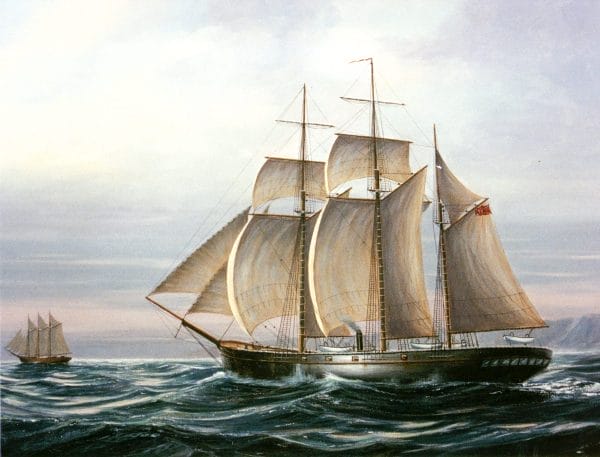 CSS Alabama
At New Orleans, Semmes oversaw the conversion of the Havana, a former packet steamer, to a commerce destroyer, renamed the CSS Sumter. Although the Sumter proved inadequate for long periods at sea, Semmes was nevertheless able to capture 18 U.S. merchant ships, seven of which were burned and the others released on bond. After six months at sea, Semmes brought the Sumter across the Atlantic Ocean to Gibraltar for badly needed repairs. Blockaded by three Union warships, including future nemesis USS Kearsarge, Semmes abandoned the Sumter, which was subsequently sold at auction. Semmes was in Nassau, the Bahamas, en route back to the Confederacy when he received official notification of his promotion to captain and orders to return to England to take command of a new ship. Construction of this vessel—originally identified only as “290”—at the Laird Shipyard in Birkenhead came about as the result of clandestine operations by the Confederate Navy’s special agent James Dunwoody Bulloch, who designed both the CSS Alabama and the CSS Florida especially for commerce raiding. Christened the Enrica to outwit Union spies, the Alabama narrowly escaped to sea, and Semmes took command of the ship at Terceira in the Azores.
CSS Alabama
At New Orleans, Semmes oversaw the conversion of the Havana, a former packet steamer, to a commerce destroyer, renamed the CSS Sumter. Although the Sumter proved inadequate for long periods at sea, Semmes was nevertheless able to capture 18 U.S. merchant ships, seven of which were burned and the others released on bond. After six months at sea, Semmes brought the Sumter across the Atlantic Ocean to Gibraltar for badly needed repairs. Blockaded by three Union warships, including future nemesis USS Kearsarge, Semmes abandoned the Sumter, which was subsequently sold at auction. Semmes was in Nassau, the Bahamas, en route back to the Confederacy when he received official notification of his promotion to captain and orders to return to England to take command of a new ship. Construction of this vessel—originally identified only as “290”—at the Laird Shipyard in Birkenhead came about as the result of clandestine operations by the Confederate Navy’s special agent James Dunwoody Bulloch, who designed both the CSS Alabama and the CSS Florida especially for commerce raiding. Christened the Enrica to outwit Union spies, the Alabama narrowly escaped to sea, and Semmes took command of the ship at Terceira in the Azores.
For almost two years, Semmes and his crew traversed the Atlantic and Indian oceans, eluding all pursuers. Of the total of 64 enemy vessels captured, 63 were either burned or released on bond, and one was converted into the satellite raider Tuscaloosa. Adding to Semmes’s notoriety was his defeat of the USS Hatteras off the Texas coast on January 1, 1863, while masquerading the Alabama as a British vessel. Semmes was a solitary figure, leaving the daily operation of his ship to his competent executive officer, Lt. John McIntosh Kell. To his crew, he was known as “Old Beeswax,” for his habit of twisting his waxed moustache while pacing the quarterdeck.
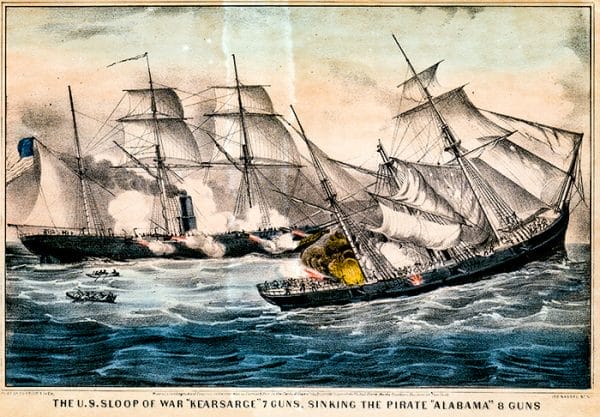 Sinking of the CSS Alabama
In mid-June 1864, Semmes sailed the Alabama to Cherbourg, France, for badly needed repairs requiring a dry dock. The subsequent arrival of the USS Kearsarge, a sloop of war commanded by Capt. John W. Winslow, forced Semmes to choose between remaining in port, fighting, or fleeing. Believing that the two ships were evenly matched, he decided to fight. On June 19, 1864, outside Cherbourg harbor, the two vessels engaged in a battle that lasted just over an hour and ended with the sinking of the Alabama. The Kearsarge’s powerful pivot guns and superior marksmanship proved decisive, whereas a shot from the Alabama that lodged in the Kearsarge’s sternpost failed to explode. Deteriorated gunpowder proved to be a critical factor in Semmes’s defeat. Semmes and several others were rescued by the crew of an English yacht and brought to England, where Semmes was feted by his many admirers. He later claimed that Winslow had cheated by protecting his ship’s engines with chains slung over the sides of his ship and covered over with boards. Had he known this, Semmes insisted, he would never have fought the ironclad. In a book published in 1896, former Alabama officer Lt. Arthur Sinclair claimed that Semmes had learned of the chains shortly before the battle, but his contention brought heated denials from other surviving Alabama officers.
Sinking of the CSS Alabama
In mid-June 1864, Semmes sailed the Alabama to Cherbourg, France, for badly needed repairs requiring a dry dock. The subsequent arrival of the USS Kearsarge, a sloop of war commanded by Capt. John W. Winslow, forced Semmes to choose between remaining in port, fighting, or fleeing. Believing that the two ships were evenly matched, he decided to fight. On June 19, 1864, outside Cherbourg harbor, the two vessels engaged in a battle that lasted just over an hour and ended with the sinking of the Alabama. The Kearsarge’s powerful pivot guns and superior marksmanship proved decisive, whereas a shot from the Alabama that lodged in the Kearsarge’s sternpost failed to explode. Deteriorated gunpowder proved to be a critical factor in Semmes’s defeat. Semmes and several others were rescued by the crew of an English yacht and brought to England, where Semmes was feted by his many admirers. He later claimed that Winslow had cheated by protecting his ship’s engines with chains slung over the sides of his ship and covered over with boards. Had he known this, Semmes insisted, he would never have fought the ironclad. In a book published in 1896, former Alabama officer Lt. Arthur Sinclair claimed that Semmes had learned of the chains shortly before the battle, but his contention brought heated denials from other surviving Alabama officers.
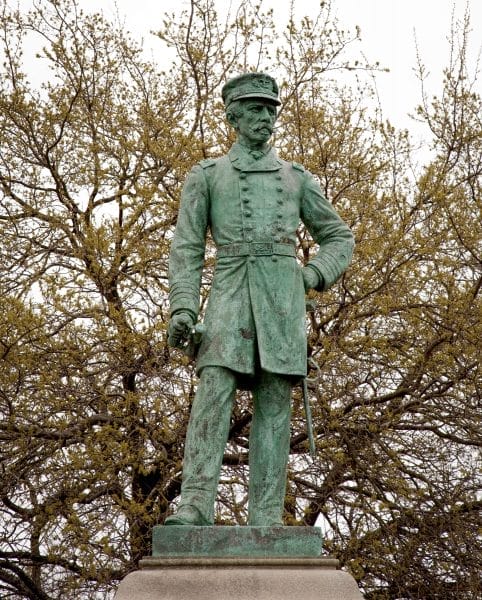 Raphael Semmes Statue
Semmes returned to the Confederacy in December 1864 and, following his promotion to rear admiral in February 1865, was given command of the small James River Squadron. When the loss of Richmond became imminent, Semmes destroyed his ships on April 2 and brought the Confederate naval cadets to Danbury, Virginia. Designated a brigadier general by Jefferson Davis, Semmes and his cadets escorted the fleeing president south. Semmes was with Gen. Joseph E. Johnston in North Carolina when Johnston surrendered his army on April 26, 1865. Although Semmes originally was paroled with the rest of the army, he was later arrested and imprisoned at the New York Navy Yard. Charges of treason, piracy, and ill treatment of prisoners proved groundless, however, and Semmes was released after three months without having been brought to trial. He was elected probate judge of Mobile County in May 1866 but prohibited from taking office by U.S. authorities. After brief employment as a professor at Louisiana State Seminary and as editor of the Memphis Daily Bulletin, Semmes returned to Mobile, where he practiced law, delivered lectures, and wrote Memoirs of Service Afloat During the War Between the States. He died in Mobile on August 30, 1877, after contracting food poisoning, and was buried in that city’s Catholic Cemetery. Southerners in search of heroes of their “Lost Cause” found Semmes well suited to the role. The cavalier officer had inflicted considerable harm to his opponents, had fought a gallant duel, and after the war gained sympathy for his imprisonment among Confederate sympathizers by the federal government. A bronze statue of Semmes was dedicated in downtown Mobile on June 27, 1900, to honor his contributions to the Confederate cause. It was removed in June 2020 and relocated to the History Museum of Mobile.
Raphael Semmes Statue
Semmes returned to the Confederacy in December 1864 and, following his promotion to rear admiral in February 1865, was given command of the small James River Squadron. When the loss of Richmond became imminent, Semmes destroyed his ships on April 2 and brought the Confederate naval cadets to Danbury, Virginia. Designated a brigadier general by Jefferson Davis, Semmes and his cadets escorted the fleeing president south. Semmes was with Gen. Joseph E. Johnston in North Carolina when Johnston surrendered his army on April 26, 1865. Although Semmes originally was paroled with the rest of the army, he was later arrested and imprisoned at the New York Navy Yard. Charges of treason, piracy, and ill treatment of prisoners proved groundless, however, and Semmes was released after three months without having been brought to trial. He was elected probate judge of Mobile County in May 1866 but prohibited from taking office by U.S. authorities. After brief employment as a professor at Louisiana State Seminary and as editor of the Memphis Daily Bulletin, Semmes returned to Mobile, where he practiced law, delivered lectures, and wrote Memoirs of Service Afloat During the War Between the States. He died in Mobile on August 30, 1877, after contracting food poisoning, and was buried in that city’s Catholic Cemetery. Southerners in search of heroes of their “Lost Cause” found Semmes well suited to the role. The cavalier officer had inflicted considerable harm to his opponents, had fought a gallant duel, and after the war gained sympathy for his imprisonment among Confederate sympathizers by the federal government. A bronze statue of Semmes was dedicated in downtown Mobile on June 27, 1900, to honor his contributions to the Confederate cause. It was removed in June 2020 and relocated to the History Museum of Mobile.
Further Reading
- Delaney, Norman C. “Fight or Flee: Raphael Semmes’ Decision to Engage the Kearsarge, June, 1864.” Journal of Confederate History 4 (Special Commemorative Naval Issue, 1989): 17-28.
- Semmes, Raphael. Memoirs of Service Afloat During the War Between the States. 1869. Edited by John M. Taylor. Reprint, Baton Rouge: Louisiana State University Press, 1996.
- Spencer, Warren F. “Raphael Semmes; Confederate Raider.” In Captains of the Old Steam Navy, James C. Bradford, ed. Annapolis: Naval Institute Press, 1986. Pp. 194-226.
- ———. Raphael Semmes: The Philosophical Mariner. Tuscaloosa: University of Alabama Press, 1997.
- Taylor, John M. Confederate Raider: Raphael Semmes of the Alabama. Washington: Brassey’s, 1994.


